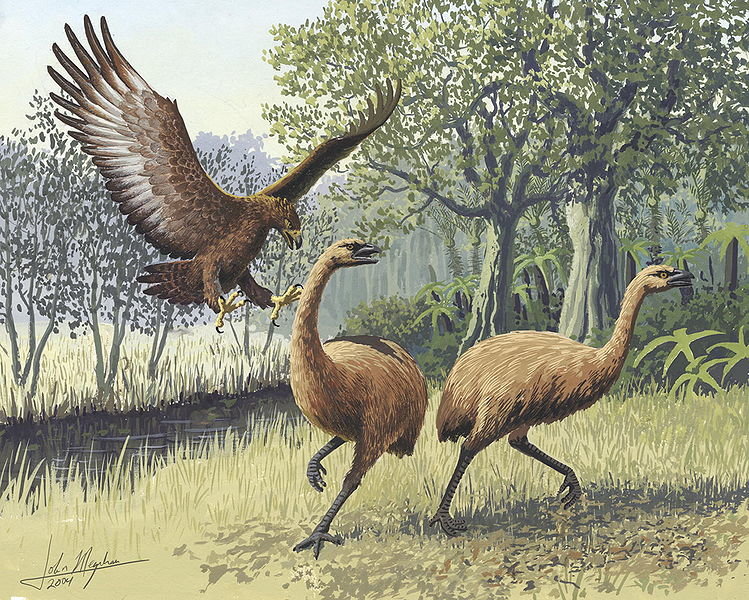
Could you expand further on your development of high-resolution chronologies for prehistoric extinction events?
I am interested in using new statistical methods to make use of existing data (e.g. radiocarbon dates on bones) to estimate the timing of extinctions. This is important as it helps us to understand the fragility populations and provides baselines for modern change.
What animals or plants are the closest to extinction in the next ten years?
Many! Generally slow-breeding, large animals with specific habitat requirements are most at risk. In plants the drivers vary but include habitat loss, over-collection (e.g. for cactus and orchids) and invasive herbiovores.
What is your stance on the de-extinction dilemma – should we attempt to bring back the moa?
My thoughts on this are that it is an interesting idea, but one with lots of moral and ethical questions attached the technical ones notwithstanding. Two that spring to mind are: (i) should we pursue the resurrection of extinct species if there are plenty of extant ones that are endangered (assuming there is not infinite money/resource for both) and (ii) should we resurrect species where the processes that drove them to extinction still exist? There are various other things that need to be considered and that we have little idea about; for example, what if moa turned out to be perfect dispersers of weed seeds?
Should extinction be blamed squarely on humans?
Extinction is a natural process and is the fate of all species. Using the geological record we can estimate the ‘background rate’ of extinction. However, current rates of extinction are much higher than the background rate and the last few hundred years this is directly and indirectly attributable to human activity. In the past there have been mass extinction events where large numbers of species have gone extinct – a famous, but not the most severe, example is the extinction of the dinosaurs at the end of the Cretaceous. There is concern that humans are triggering another such mass extinction.
What are some ways humans can better protect our struggling creatures?
We can make better decisions as a society and as individuals about resource use to limit the footprint of our actions. Habitat loss remains the single best driver of species loss and consumer decisions are a contributor to this. There is also a powerful role for education and outreach to help; better understand the date that many of our plants and animals face.
What could our government do to better serve our native animals?
At one level, this is a matter of investment in institutions like DoC and local government, etc.. But other decisions re funding and policy making around the economy are also important. There is an ongoing need for a discussion about what we want NZ to look like in the future, how we can be better stewards of the land and sea, and how we balance the needs of economic and ecological systems.
What emerging technologies have helped biodiversity and aided extinction?
In many cases the biggest knowledge gap remains in a lack of understanding of the basic biology of the species we are concerned about. Modern advances in computing and associated methods have been revolutionary; for example, the development of geospatial technologies (e.g. GPS) have transformed our ability to monitor rare species an design efficient control schemes. Genetic technologies are being used to understand the risks faced by rare species (e.g. inbreeding) and may have a role in invasive species management (although there are ethical questions here).
How does New Zealand compare to other countries in regard to protecting biodiversity?
I think there is a reasonably good public awareness of the general problems our biodiversity faces, partly as a result of initiatives such as PFNZ 2050. On the other hand, there is still plenty of room for improvement in all sorts of areas!
Some research suggests mammals that disappear tend to be 100 to 1000 times bigger than those that survive – is this true?
Yes, over the last 50000 years or so most of the earth’s megafauna (animals greater than 1000 kg) have disappeared. There has been ongoing debate about the role of humans vs climate change in this extinction, but no doubt that large animals seem to have suffered disproportionately. Recent research suggests that this ‘defaunation’ has had cascading effects to other ecosystem components.
What are some other trends about what type of animals tend to die off and what survives?
As noted above large, slow-breeding animals (often log-lived) are most vulnerable. Species that require on very specific habitats or that are migratory are also vulnerable. These traits are not inherently ‘bad’ but animals with them struggle to adapt to environmental change, invasive species, etc. Traits that tend to evolve on islands such as flightlessness also render species vulnerable to extinction – islands are centres of biodiversity and extinction.
Is there a chance that all animals will die out and we will be left with cows and robots?
I don’t think so – I’d put my money on cockroaches and jellyfish among animals!




